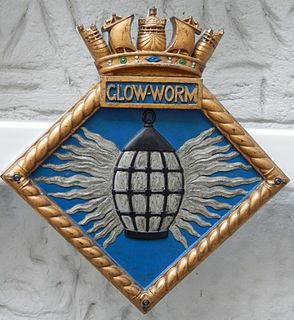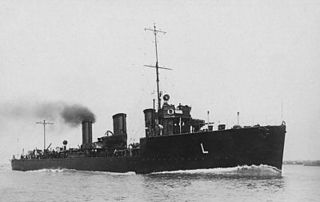Related Research Articles
Eight ships of the Royal Navy have been named HMS Ardent, whilst another two were planned:
Thirteen ships of the British Royal Navy have been named HMS Surprise or HMS Surprize, including:
Five ships of the Royal Navy have been named HMS Achates after Achates, a character in Roman mythology. A sixth was planned but never completed:

Three ships of the Royal Navy have borne the name HMS Glowworm after the insect, whilst two more were planned:
Six ships of the Royal Navy have been named HMS Foxhound. A seventh was planned but never completed:
Seven ships of the Royal Navy have been named HMS Orpheus. Orpheus was the magical father of songs in Greek mythology.
Three ships of the Royal Navy have borne the name HMS Battleaxe:
Three ships of the Royal Navy have been named HMS Onslow:
Several ships of the British Royal Navy have been named HMS Partridge, after the bird.
Eight ships of the Royal Navy have borne the name HMS Defender:

HMS Laertes was a Laforey-class destroyer built for the Royal Navy during the 1910s.
Three vessels of the British Royal Navy have been named HMS Nerissa:
Three ships of the British Royal Navy have been named HMS Observer:
Five ships of the Royal Navy have borne the name HMS Cynthia. A sixth was planned but never completed:
Seven ships of the Royal Navy have borne the name HMS Victor:
Three ships of the Royal Navy have borne the name HMS Laertes, after either Laertes, a figure in Greek mythology, or Laertes, a character in Shakespeare's Hamlet:
Several vessels of the Royal Navy have borne the name HMS Pigeon.
There have been two ships of the Royal Navy named HMS Rosalind, named after the protagonist in William Shakespeare's As You Like It:

HMS Sarpedon was an R-class destroyer which served with the Royal Navy. he R class were a development of the preceding M-class, but differed in having geared turbines and other design changes. Launched in June 1916, the vessel escorted convoys that sailed between Scotland and Scandinavia in the First World War. After the war, the ship was allocated to local defence at Nore. However, in 1923, the Navy decided to retire many of the older vessels and Sarpedon was retired and was sold to be broken up on 23 June 1926.
There have been three ships of the Royal Navy named HMS Redgauntlet after the novel by Sir Walter Scott:
References
- ↑ Colledge, J.J.; Warlow, Ben (2006). Ships of the Royal Navy: The Complete Record of All Fighting Ships of the Royal Navy . London: Chatham Press. p. 359. ISBN 978-1-8617-6281-8.
- ↑ Manning, Thomas Davys; Walker, Charles Frederick (1959). British Warship Names. London: Putnam. p. 394.